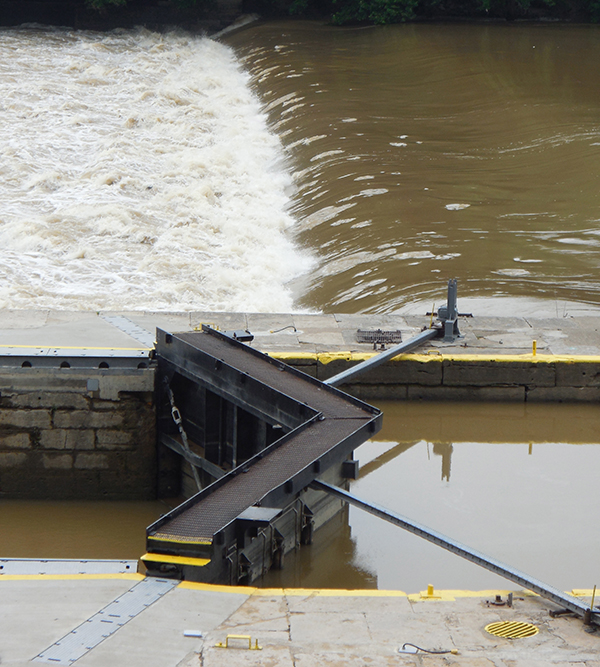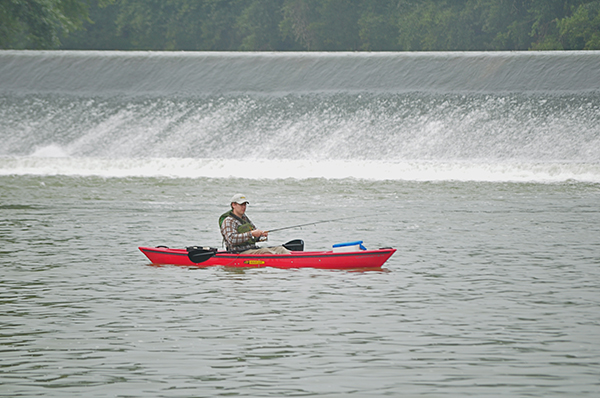Seasonal flooding impacts fish populations in Kentucky’s rivers, lakes, and small streams. The impacts are both positive and negative, with short term and long term implications.
Here’s some observations on flood-related impacts:

The Kentucky River is basically a series of lakes under normal water conditions, but during floods it becomes a raging river as water cascades over dams, creating a surge of current that pushes fish from pool to pool, downstream. (Photo provided)
• The Kentucky River, which is 260 miles long, is impounded by 14 locks and dams.
“In summer it’s basically a series of lakes, in high water it becomes a river again,” said Jeff Crosby, Central District Fishery Biologist for the Kentucky Department of Fish and Wildlife Resources (KDFWR).
Flood waters cascade over dams, creating a surge of current that pushes fish from pool to pool, downstream. Crosby said in the Palisades, a section of the river with steep gorges and limestone outcroppings that stretch for about 100 miles, fish have few places to escape the current. “Fish migrate. Muskies move down river,” said Crosby.
• In major reservoirs, when the gates are opened on dams to release high water, lakes lose fish.
“But this produces good fishing below dams in tailwaters,” said Crosby. “Two examples are walleye below Green River Lake Dam and hybrid striped bass below Barren River Lake Dam.”

In major reservoirs, when the gates are opened on dams to release high water during floods, lakes lose fish, but when water levels stabilize, there’s good fishing below dams in tailwaters. (Photo provided)
• But floods can also move undesirable fish species downstream, with negative fishery management consequences such as the introduction of gizzard shad into a small lake being managed for largemouth bass and bluegills.
One lake that was impacted by shad from upstream in past floods was Cedar Creek Lake. The 784-acre impoundment off U.S. 50 in Lincoln County between Stanford and Crab Orchard, has been managed as a trophy largemouth bass lake since its impoundment in 2003.
•The timing of a flood is critical, and the later in the year they occur, the greater the potential for a negative impact on fish reproductive success.
In this context, late winter flooding is preferable to spring flooding.
“With a spring flood there can be issues with the spawn,” said Crosby.
Entire spawns may be lost or severely compromised by yo-yo-ing water levels.
The worst case scenario is “it’s April and fish are trying to spawn in lakes, then the water level abruptly drops,” said Crosby.

For opportunistic anglers, late winter floods can create good spring fishing, after water levels return to normal, especially in lake headwaters, and below dams. (Photo by Art Lander Jr.)
• Late winter/early spring floods can create dissolved oxygen issues for fish in major reservoirs that aren’t apparent until the fall.
When there’s a massive flood, lakes fill up fast and discharges intensify. This pulls out the cold, highly-oxygenated water being stored in the reservoir that’s needed by fish during the hot, dry weather in late summer and fall.
“We’ve seen this happen at Taylorsville Lake,” said Crosby. “There’s very low dissolved oxygen levels on the main lake in the fall, shad are stressed on the surface, and fish move into creeks (embayments) where oxygen levels are higher.”
Flooding also moves a lot of sediment into lakes, creating organic loading, which can be a factor in low dissolved oxygen levels in the fall.
• High water in small streams can destroy and/or create fish habitat.
“Not all streams have stable habitat,” said Crosby, “In some streams, a lot of wood and rock gets moved around during floods.”
If it’s a flash flood, fish may try to get out of the current by swimming out of the channel, but end up get entrapped in small streamside pools in fields, when water levels abruptly drop.

When flooding rivers or streams inundate farmlands, the ponds and small lakes on the property can be negatively impacted. Grass carp, stocked to control aquatic vegetation, often escape into the waterway that flooded the farm. This results in a financial loss to the landowner. (Photo provided)
• Higher water levels in lakes after flooding can actually improve conditions for fish making their annual spawning runs.
“The current encourages fish to move into lake headwaters, and farther up rivers,” said Crosby.
This happens with white bass in Taylorsville Lake and Herrington Lake, walleye in Lake Cumberland, and saugeye in Guist Creek Lake.
• When flooding rivers or streams inundate farmlands, the ponds and small lakes on the property can be negatively impacted.
While largemouth bass and bluegills may stay put, catfish and grass carp usually ride the current, escaping into the waterway that flooded the farm.
This results in a financial loss to the landowner who has to buy more fish for stocking — catfish to keep bluegill numbers under control, and grass carp to control aquatic vegetation.
Floods happen, but it often takes a while for biologists to assess the impacts to fisheries.
For opportunistic anglers, late winter floods can create good spring fishing, after water levels return to normal, especially in lake headwaters, and below dams.
Art Lander Jr. is outdoors editor for KyForward. He is a native Kentuckian, a graduate of Western Kentucky University and a life-long hunter, angler, gardener and nature enthusiast. He has worked as a newspaper columnist, magazine journalist and author and is a former staff writer for Kentucky Afield Magazine, editor of the annual Kentucky Hunting & Trapping Guide and Kentucky Spring Hunting Guide, and co-writer of the Kentucky Afield Outdoors newspaper column.
http://www.nkytribune.com/2018/03/art-landers-outdoors-seasonal-flooding-impacts-fish-populations-in-kentuckys-waterways/Bagikan Berita Ini
















0 Response to "Art Lander's Outdoors: Seasonal flooding impacts fish populations in Kentucky's waterways"
Post a Comment